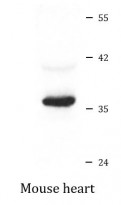ARG57561
anti-COPS6 antibody
anti-COPS6 antibody for ICC/IF,Western blot and Human,Mouse,Rat
Overview
| Product Description | Rabbit Polyclonal antibody recognizes COPS6 |
|---|---|
| Tested Reactivity | Hu, Ms, Rat |
| Tested Application | ICC/IF, WB |
| Host | Rabbit |
| Clonality | Polyclonal |
| Isotype | IgG |
| Target Name | COPS6 |
| Antigen Species | Human |
| Immunogen | Recombinant protein of Human COPS6. |
| Conjugation | Un-conjugated |
| Alternate Names | Vpr-interacting protein; Signalosome subunit 6; COP9 signalosome complex subunit 6; MOV34 homolog; SGN6; CSN6; JAB1-containing signalosome subunit 6; MOV34-34KD; hVIP |
Application Instructions
| Predict Reactivity Note | Human | ||||||
|---|---|---|---|---|---|---|---|
| Application Suggestion |
|
||||||
| Application Note | * The dilutions indicate recommended starting dilutions and the optimal dilutions or concentrations should be determined by the scientist. | ||||||
| Positive Control | Mouse heart | ||||||
| Observed Size | 36 kDa |
Properties
| Form | Liquid |
|---|---|
| Purification | Affinity purified. |
| Buffer | PBS (pH 7.3), 0.02% Sodium azide and 50% Glycerol. |
| Preservative | 0.02% Sodium azide |
| Stabilizer | 50% Glycerol |
| Storage Instruction | For continuous use, store undiluted antibody at 2-8°C for up to a week. For long-term storage, aliquot and store at -20°C. Storage in frost free freezers is not recommended. Avoid repeated freeze/thaw cycles. Suggest spin the vial prior to opening. The antibody solution should be gently mixed before use. |
| Note | For laboratory research only, not for drug, diagnostic or other use. |
Bioinformation
| Database Links |
Swiss-port # O88545 Mouse COP9 signalosome complex subunit 6 Swiss-port # Q7L5N1 Human COP9 signalosome complex subunit 6 |
|---|---|
| Gene Symbol | COPS6 |
| Gene Full Name | COP9 signalosome subunit 6 |
| Background | The protein encoded by this gene is one of the eight subunits of COP9 signalosome, a highly conserved protein complex that functions as an important regulator in multiple signaling pathways. The structure and function of COP9 signalosome is similar to that of the 19S regulatory particle of 26S proteasome. COP9 signalosome has been shown to interact with SCF-type E3 ubiquitin ligases and act as a positive regulator of E3 ubiquitin ligases. This protein belongs to translation initiation factor 3 (eIF3) superfamily. It is involved in the regulation of cell cycle and likely to be a cellular cofactor for HIV-1 accessory gene product Vpr. [provided by RefSeq, Jul 2008] |
| Function | Component of the COP9 signalosome complex (CSN), a complex involved in various cellular and developmental processes. The CSN complex is an essential regulator of the ubiquitin (Ubl) conjugation pathway by mediating the deneddylation of the cullin subunits of SCF-type E3 ligase complexes, leading to decrease the Ubl ligase activity of SCF-type complexes such as SCF, CSA or DDB2. The complex is also involved in phosphorylation of p53/TP53, c-jun/JUN, IkappaBalpha/NFKBIA, ITPK1 and IRF8, possibly via its association with CK2 and PKD kinases. CSN-dependent phosphorylation of TP53 and JUN promotes and protects degradation by the Ubl system, respectively. Has some glucocorticoid receptor-responsive activity. Stabilizes RFWD2/COP1 through reducing RFWD2 auto-ubiquitination and decelerating RFWD2 turnover rate, hence regulates the ubiquitination of RFWD2 targets. [UniProt] |
| Calculated MW | 36 kDa |
Images (1) Click the Picture to Zoom In






